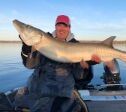- 0



By SkunkedAgain · Posted



By CigarGuy · Posted
.thumb.jpg.5c1a86e9339e49e53f5bfefed2220054.jpg)
By LakeofthewoodsMN · Posted

By Brianf. · Posted
By using this site, you agree to our Terms of Use and Privacy Policy. We have placed cookies on your device to help make this website better. You can adjust your cookie settings, otherwise we'll assume you're okay to continue.

Question
orangestew
I'm in the market for some new boots and am not sure what the best choice would be. I'm tired of getting wet and cold feet, my boots are wore out. They have lasted 9 years I think it's about time for new ones.
Is there really a big difference in how many grams of thinsulate a person gets? I don't want my feet to get to hot when it comes to grouse and pheasant hunting and at the same time I would like my toes to stay warm during the deer firearms seasons.
Probably the obvious choice would be to pick the one in the middle. I was looking at a pair that have the 1000 grams and they felt pretty nice but just for the few minutes I had them on my feet did start to feel warm "indoors". Maybe it was because I was expecting them to get hot, mental thing.
Would I be unhappy going with the 1000g for an over all boot? Should I be going with the 600g to have more comfortable feet in the early fall? Am I expecting to much from one boot? Is there a boot that is good for all seasons?
What has been everyones experience when it comes to boots?
Link to comment
Share on other sites
12 answers to this question
Recommended Posts